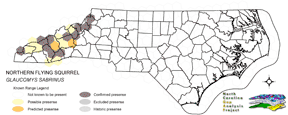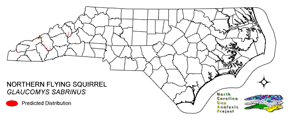
| Taxa: |
| Order: |
| Family: |
| Mammalia |
| Rodentia |
| Sciuridae |
| NatureServe Global Rank: |
| NatureServe State (NC) Rank: |
| G5 |
| S1 |
| Federal Status: |
| NC State Status: |
| --- |
| --- |


| Land Unit |
| US Fish & Wildlife Service |
| US Forest Service |
| US National Park Service |
| US Department of Defense |
| NC State Parks |
| NC University System |
| NC Wildlife Res. Com. |
| NC Forest Service |
| NC Div. of Coastal Mgmt. |
| Local Governments |
| Non-Governmental Org. |
| Other Public Lands |
| Private Lands |
| GAP Status 1-2 |
| All Protected Lands |
| Statewide |
| Hectares |
| 0.00 |
| 6,323.67 |
| 0.00 |
| 10,646.64 |
| 443.97 |
| 0.00 |
| 9.81 |
| 0.00 |
| 0.00 |
| 479.07 |
| 1,022.31 |
| 0.00 |
| 3,510.99 |
| 13,617.72 |
| 18,917.01 |
| 22,436.46 |
| Acres |
| 0.00 |
| 15,626.13 |
| 0.00 |
| 26,308.42 |
| 1,097.07 |
| 0.00 |
| 24.24 |
| 0.00 |
| 0.00 |
| 1,183.81 |
| 2,526.18 |
| 0.00 |
| 8,675.84 |
| 33,650.11 |
| 46,744.94 |
| 55,441.69 |
| % of Dist. on |
| Prot. Lands |
| 0.0 % |
| 33.4 % |
| 0.0 % |
| 56.3 % |
| 2.3 % |
| 0.0 % |
| < 0.1 % |
| 0.0 % |
| 0.0 % |
| 5.4 % |
| 5.4 % |
| 0.0 % |
| 0.0 % |
| 72.0 % |
| ----- |
| ----- |
| % of Dist. on |
| All Lands |
| 0.0 % |
| 28.2 % |
| 0.0 % |
| 47.5 % |
| 2.0 % |
| 0.0 % |
| < 0.1 % |
| 0.0 % |
| 0.0 % |
| 2.1 % |
| 4.6 % |
| 0.0 % |
| 15.6 % |
| 60.7 % |
| ----- |
| ----- |
|
This species is found on the peaks of a few high mountain ranges in North Carolina, primarily where stands of boreal conifers (red spruce and fraser fir) are present (Webster et al. 1985). Glaucomys sabrinus is associated with older forests of spruce-fir-birch and hemlock-birch located in the upper elevations of the southern Appalachian mountains, but can be found in mid-elevation hardwoods (Linzey and Linzey 1971, Whitaker and Hamilton 1998). Population sizes are greatly limited by the availability of old, cavity-filled trees, primarily yellow birch, in which they find shelter and nest. NATURE SERVE GLOBAL HABITAT COMMENTS: Prefers coniferous and mixed forest, but will utilize deciduous woods and riparian woods. Optimal conditions have been reported as cool, moist, mature forest with abundant standing and down snags. In the Oregon Cascades, Rosenberg and Anthony (1992) concluded that flying squirrels are habitat generalists and are not more abundant in old growth than in younger, second-growth stands. Occupies tree cavities, leaf nests, underground burrows; uses large number in alternate den sites in Alaska (Austin et al., no date). See Payne et al. (1989) for habitat characteristics of endangered Appalachian populations. Prefers cavities in mature trees as den sites. Small outside twig nests sometimes are used for den sites. Sometimes uses bluebird boxes. |
| Code | Name | Description | NC Natural Heritage Program Equivalent |
| 521 | Spruce/Fir Forest | High Elevation Frazer-Fir - Red Spruce, Red Spruce and Red-Spruce-Yellow Birch Forests. Tree densities included here include both woodland to forest density. Highly intermixed with Northern Hardwoods, Grassy Balds, and Shrub Balds. | Red Spruce--Fraser Fir Forest, Fraser Fir Forest |
| 522 | Northern Hardwoods | High Elevation forests including yellow birch, American beech, and yellow buckeye. Includes forests with Hemlock and Yellow Birch. | Northern Hardwoods Forest, Boulderfield Forest |
| 527 | Appalachian Hemlock | Upland hemlock forests of the moutains region. Vary from side slopes to steep slope positions. | Canada Hemlock Forest |
|
Maser, C., and Z. Maser. 1988. Interactions among squirrels, mycorrhizal fungi, and coniferous forests in Oregon. Great Basin Nat. 48:358-369.
Rosenberg, D. K., and R. G. Anthony. 1992. Characteristics of northern flying squirrel populations in young second- and old-growth forests in western Oregon. Can. J. Zool. 70:161-166. Howell, A. H. 1918. Revision of the American flying squirrels. North American Fauna 44:1-64. Jones, J. K., Jr., et al. 1992. Revised checklist of North American mammals north of Mexico, 1991. Occas. Pap. Mus., Texas Tech Univ. (146):1-23. Weigl, P.D. and D.W. Osgood. 1974. Study of the northern flying squirrel, Glacomys sabrinus, by temperature tele- metry. Am. Midl. Nat. 92(2):482-486. Witt, J. W. 1992. Home range and density estimates for the northern flying squirrel, GLAUCOMYS SABRINUS, in western Oregon. J. Mamm. 73:921-929. Wilson, D. E., and D. M. Reeder (editors). 1993. Mammal Species of the World:a Taxonomic and Geographic Reference. Second Edition. Smithsonian Institution Press, Washington, DC. xviii + 1206 pp. Whitaker, J.O. Jr. and W.J. Hamilton, Jr. 1998. Mammals of the eastern United States. Cornell Univ. Press, Ithaca, New York. 583 pp. Payne, J. L., D. R. Young, and J. F. Pagels. 1989. Plant community characteristics associated with the endangered northern flying squirrel, Glaucomys sabrinus, in the southern Appalachians. American Midland Naturalist 121:285-292. Austin, K., et al. No date. Northern flying squirrel draft recovery plan. U.S. Fish and Wildlife Service Region 5. 52 pp. Linzey, Alicia V., & Donald W. Linzey. 1971. Mammals of the Great Smoky Mountains National Park. The University of Ten- nessee Press, Knoxville, Tennessee. 114 p. Banfield, A.W.F. 1974. The mammals of Canada. University of Toronto Press, Toronto. Hamilton, William J., Jr., and John O. Whitaker, Jr. 1979. Mammals of the eastern United States. Cornell Univ. Press, Ithaca, New York. 346 pp. Wells-Gosling, N. and L.R. Heaney. 1984. Glaucomys sabrinus. Am. Soc. Mamm., Mammalian Species No. 229. 8 pp. Hall, E. R. 1981. The Mammals of North America. Second edition. 2 Volumes. John Wiley and Sons, New York, New York. Baker, Rollin H. 1983. Michigan mammals. Michigan State University Press. 642 pp. Webster, W. D., J. F. Parnell and W. C. Biggs Jr. 1985. Mammals of the Carolinas, Virginia, and Maryland. The University of North Carolina Press, Chapel Hill, NC. Matthews, J. R., and C. J. Moseley (editors). 1990. The Official World Wildlife Fund Guide to Endangered Species of North America. Volume 1. Plants, Mammals. xxiii + pp 1-560 + 33 pp. appendix + 6 pp. glossary + 16 pp. index. Volume 2. Birds, Reptiles, Amphibians. |
For more information please contact them at:
NC-GAP Analysis Project
Dept. of Zoology, NCSU
Campus Box 7617
Raleigh, NC 27695-7617
(919) 513-2853
www.basic.ncsu.edu/ncgap